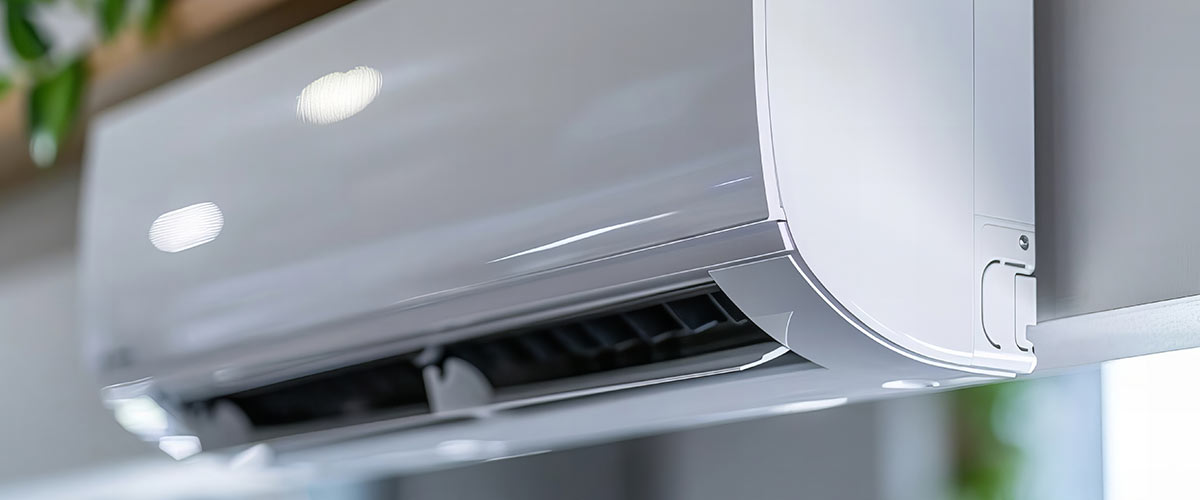Your mini split is throwing a blinking light at you. The bedroom still feels stuffy, and the outdoor unit is humming as if it’s thinking about working but not fully committing. You can hear that soft tick-tick of the indoor fan ramping up and down from here. When my unit behaved like that last August, the air coming out felt more like a warm sigh than a cool breeze. I also found a little drip marching across my baseboard. If you notice anything similar to your unit, don’t panic. Most ductless issues stem from simple causes, such as incorrect settings, inadequate airflow, or a clogged drain. Let’s walk through what to check and how to prevent it from pulling this stunt again—without turning your house into a mechanic’s bay. Remember, it’s a straightforward process that you can handle with ease.
What is a Ductless Mini Split?
A ductless mini split is really two main parts having a quiet conversation: the indoor air handler on the wall and the outdoor condenser. Refrigerant runs between them through a line set, moving heat out in summer and in during winter. The indoor unit pulls room air through filters, over a cold (or hot) coil, and pushes it back with a variable-speed fan. When everything is happy, you hear a gentle whoosh and feel steady, dry, comfortable air.
When things go sideways, it usually manifests as one of several symptoms: weak airflow,lukewarm discharge, frost on the indoor coil, water dripping, a sour “gym sock” smell, or flashing error codes. Common culprits include dirty filters, a clogged condensate drain, a blocked outdoor coil, an incorrect mode selection, or a communication issue between the units after a power surge. I once chased a “mystery leak” that turned out to be condensation running off a coil that had iced up due to a filthy filter. The unit wasn’t broken; it was suffocating. A little cleaning made it purr again like fresh rain on a tin roof.
Quick Fixes for Ductless Mini Split Issues
Start with the basics on the remote. Ensure you’re in Cool (snowflake) or Heat (sun) mode, not Auto, and set the temperature at least 4 degrees above the room temperature. The auto mode can get cute and switch modes. Fan on Auto is good; High is fine for a quick blast. Replace the remote batteries if the display looks faint.
Next, listen. The indoor fan should ramp smoothly; the outdoor unit should hum, and the big fan should spin steadily. If you feel only a tepid draft, pull the front panel up and slide the filters out.If they look like gray felt, there’s your villain. Gently vacuum or rinse them; let them dry thoroughly before reinstalling. Use the unit’s On/Off button to power down, wait 2 minutes, and then turn it back on. If it’s still confused, then a complete power cycle at the breaker can clear control glitches.
Check the condensate drain. You should see a small PVC or clear tube exiting to the outside; during cooling, a thin, steady stream of water should drip. No drip and a gurgle inside means likely a clog. Try a wet/dry vac on the outside drain for 30 seconds, then listen for a chuckle of water inside. If the indoor coil is frosted (looks like powdered sugar), switch to Fan mode for 30-45 minutes to defrost before trying Cool again. Outside, clear leaves and lint from the condenser fins with a soft brush. Don’t bend the fins and don’t pry open panels. Notice any oily residue on connections or strong electrical smells? Stop and call a pro.
Prevention and Maintenance
Filters are the lungs of your unit. Clean them monthly in the cooling season, and every couple of months otherwise. I mark the first Saturday of the month; it takes five minutes and saves headaches. While the panel is open, shine a flashlight at the coil. It should look like clean, tight aluminum fins. If there’s light fuzz, a gentle pass with a coil-safe brush helps. For deeper grime or any moldy smell, have us do a safe coil wash. I learned the hard way: one enthusiastic spray of the wrong cleaner left my living room smelling like a motel pool for a week.
Keep the outdoor unit breathing. It’s important to allow 18 inches of clearance on all sides to ensure proper airflow and system efficiency. Trim shrubs, blow away cottonwood fluff, and gently hose pollen off the coil from the outside. No pressure washer. Once a season, flush the drain line with a cup of white vinegar to prevent slime buildup. Also, check the black insulation on the larger refrigerant line; if it’s cracked, wrap it to maintain efficiency. Add a surge protector if your electrical panel allows—power blips can scramble electronics.
Plan a professional tune-up once a year, ideally before the hottest stretch here in Milledgeville, Georgia. We’ll clean the blower wheel, check electrical connections and firmware updates, verify refrigerant pressures indirectly via temps and manufacturer charts, and confirm that the system is draining properly. It’s like rotating tires—boring until you skip it, and then suddenly very interesting.
When To Call Professionals
Call in a pro if quick fixes don’t restore strong, consistent cooling or heating within a day. Red flags: the indoor unit leaks after you’ve cleaned the filters and cleared the drain, the outdoor fan runs but the compressor remains silent, the breaker trips, or you see ice reforming quickly. Hissing at the line set, oily stains at flare connections, or a sweetish odor can indicate are refrigerant leak—do not attempt to tighten fittings yourself. Likewise, any burning smell, popping sounds, or lights dimming when the unit starts up need immediate attention.
Ductless AC installation issues often look like a breakdown. An undersized unit will run constantly and still feel clammy. Oversized ones short-cycle—cool fast, never dehumidify, and leave you sticky. If your head is mounted over a doorway or aimed directly at a thermostat in the hall, airflow patterns can confuse the controls. We assess room load, line-set length, and slope, and ensure that the installer pulled a proper vacuum and used nitrogen during brazing. On a service visit, we’ll check temperature splits, fan speeds, coil condition, drain pitch, and board diagnostics. We carry drain cleaning gear, coil-safe cleaners, and, when needed, leak detectors and electronic scales for precise charging. Before we arrive, clear a small area of floor space under the unit and take a quick video of the noise or drip; it helps us target the fix more quickly.
Common Questions
Can I run a ductless mini split AC 24/7?
Yes. Inverter mini splits like steady operation. Set a comfortable temp and let it cruise; it’ll sip power at low speed.
Why does it feel cool but humid?
Likely short cycling or the fan on high all the time. Use the Auto fan, avoid Auto mode, and ensure the unit isn’t oversized for the room.
How often do I need a pro service?
Heat pumps and other air conditioners benefit from
annual maintenance. Filter monthly, drain vinegar, and flush each season.
Is “defrost mode” normal in winter?
Yep. The outdoor unit may pause and emit a slight amount of steam. Give it a few minutes; it’s just shedding ice, so heating stays strong.
For more common questions about ductless systems, check our detailed FAQ guide.



